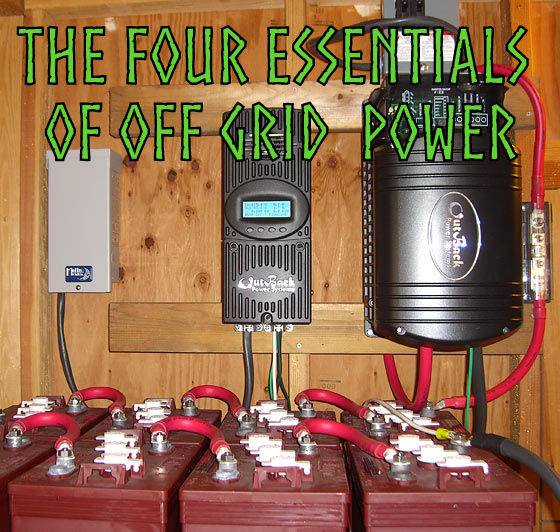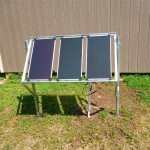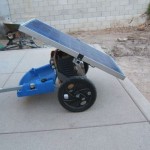Four Essentials Of Off Grid Solar
An off-grid solar (photo-voltaic) electric power system is an ideal prep for modern survival in that it can partially or totally relinquish you from dependence upon other systems, which themselves are vulnerable to disruption or breakdown.
Off-grid systems also enable the ability to live away from the mainstream, which opens the door to properties which may be more affordable than others which require connectivity to public utility systems.
Even if living in suburbia, installing an off-grid system side-by-side with the existing electrical system could provide you with a completely separate electrical circuit (separate outlets, etc… however you design it – unless you ‘grid-tie’), and reduce your dependency on the grid as well as provide a back-up means of electrical power during a grid outage or disaster situation.
Although there is much more to know regarding the proper design and construction of an off-grid solar power system, the following basic essential elements should give you a basic summary of the main components involved.
A typical off-grid system and can be split up into four sections, each with their own function and purpose as listed here.
1. Photovoltaic Solar Panels
2. Charge Controller
3. Battery Bank
4. DC to AC Inverter
PV PHOTOVOLTAIC SOLAR PANELS
The PV (PhotoVoltaic) solar panel is where it all begins. A typical solar panel is made up of an array of many small individual solar cells, made of crystalline silicone, each connected together to provide a usable amount of total power. Sunlight (photons) strike the crystalline silicon wafers, which convert that energy into electricity.
Today’s typical residential solar panel may contain enough individual cells to produce about 250 watts (although there are lots of different sizes). The more solar panels, the more power you get. While a number of years ago this panel would have cost $4 per watt, nowadays the panels are commonly priced in the vicinity of $1/watt, more or less.
To calculate the number of solar panels required (which will vary widely depending on one’s needs,) it’s all about the term ‘watts. A ‘watt’ is a unit of power.
First you need to determine the wattage of an individual appliance or device that you would like to power and multiply it’s wattage by the number of hours per day that the appliance or device may be ‘on’. The result is a unit of energy which is required to power that device – power multiplied by time. You do this for each device and add them all up to get a total number.
For example, you might want enough power to run a refrigerator, maybe a chest freezer, a number of lights, along with enough left-over energy to occasionally run a washing machine, kitchen appliance, radio or TV, and a computer, etc.
Refrigerator
A refrigerator’s internal compressor will cycle on and off throughout the day and may realistically be ‘running’ about half the time during any given day. If your refrigerator consumes 100 watts when it’s ‘on’, you would calculate the power consumption requirement as follows:
100 watts x 12 hours = 1,200 watts per day, also known as 1.2 kWh, or 1.2 kilowatt hours, which is also the same as consuming 1,200 watts in one hour.
You can determine how many watts that your devices are consuming by temporarily plugging them into one of these, which is what I currently use for testing:
Electricity Usage Monitor
Chest Freezer
(60 watts x 12 hours = 720 watts per day)
Light Bulbs (Energy Efficient CFL)
(14 watts x 6 bulbs x 6 hours = 500 watts per day)
This very simple example of operating a fridge, chest freezer and a half-dozen light bulbs add up to 2,400 watts of energy consumed in a given day, or 2.4 kWh.
Perhaps we add 600 watts as ‘extra’, which brings us to 3,000 watts of energy, or 3 kWh.
Now you need to discover the worst-case scenario regarding the number of hours of ‘good’ direct sunlight that you might get per day in your geographical location.
Let’s say the worst-case scenario for acquiring sunlight is during the middle of winter and depending on your geo location – with 4 hours of good sunlight to provide electrical charging capability through your solar panels. This means that during those 4 hours, you will need to come up with 3,000 watts of energy.
3,000 (watts) divided by 4 (hours of good sunlight) equals 750 watts of solar panel power capacity to absorb and convert 4 hours of solar energy into 3 kWh of electricity.
This means that you will need three 250-watt panels.
Well, not exactly – this calculation is based on your panels tracking the sun and angled exactly right – all the time in order to optimize the solar energy conversion. Let’s say you don’t have a ‘tracker’ and your panels are simply installed on the roof at some optimum fixed angle. In this example you may actually need 6 panels to be assured to gather enough energy…
A significant factor in an overall design is to include margin of safety (excess) so that you don’t run short of energy. You need to factor in your location, cloudy days, and other considerations. But this is just a very basic overview, so we’ll skip all that for now…
CHARGE CONTROLLER
The charge controller is the electronic device that is between the solar panel array and the battery bank (the batteries store the energy).
The charge controller provides a proper amount (and technique) of electrical charge to the battery bank.
It is intelligent in that it automatically adjusts depending upon the load on the system, and the state-of-charge of the batteries – versus the amount of available power from the solar panels at any given moment (at least the better ones do this).
A good charge controller will also perform maintenance functions on your batteries to help keep them in optimum condition and to prolong their life. The charge controller is an essential component in the overall system.
BATTERY BANK
The battery bank is unique to the off-grid system (as opposed to a ‘grid-tie’ system which doesn’t use them).
Since you do not consume all of your daily energy requirements during only daylight hours, an off-grid system will store the energy that is collected during daylight into a bank of batteries to be used when the solar panels are no longer in the sunlight.
(With a grid-tie system, and during a grid power outage, you will not have electricity when there’s no sunlight)
The batteries used in solar power systems are manufactured uniquely and are designed for ‘deep-cycle’ conditions with a rugged and heavy-duty internal design.
An additional consideration for the overall solar power system is the number of backup days that you may want to have energy in reserve – during times when the sun is covered by clouds during periods of bad weather.
It is important to have a few days reserve energy, which means having more batteries to store that energy.
These batteries are very heavy; they require specific cabling and inter-connectivity depending on system design; there are special considerations for their placement (environmental temperature, proper exhaust – depending on battery type, and safety).
DC to AC INVERTER
The Inverter is located at the last stage of the solar power system. Its job is to convert the DC (direct current) energy from your battery bank into AC (alternating current) energy that is used in the typical home.
‘DC’ refers to direct current, and ‘AC’ refers to alternating current. ‘AC’ is what is generated in electrical utility power plants and sent to homes to power appliances, etc.
You will need this inverter unless you have special appliances and lighting to operate on DC power.
Today’s modern inverters can be very efficient, so hardly any power is lost during the conversion process assuming you’ve purchased a quality unit.
There are cheap inverters out there which I caution against for several reasons, including the ability to handle short-term high current loads from motors and compressors starting up (refrigerators and freezers for example). Better inverters provide pure sine wave AC power and will not damage your appliances (or electronics).
Source: Asgard Clean Energy via Facebook post at https://www.facebook.com/notes/asgard-clean-energy/the-four-essentials-of-off-grid-solar/808250649273290
 This is an aggregated site. Please be aware some of the sites we link to could have pop ups. We have no control over them. However, we will never link you to a site that requires you to make any purchase to view the blog.
This is an aggregated site. Please be aware some of the sites we link to could have pop ups. We have no control over them. However, we will never link you to a site that requires you to make any purchase to view the blog.
Please read our disclaimer. We provide you with information from various sites all over the world. The author’s expressed opinion isn’t necessarily that of The Prepared Page or its staff. Our intent is to bring you the information. Use your and your own best judgment when using any information contained within the blogs.
While you’re here check out some of the other posts you may find them interesting!!!
Some posts may contain affiliate links.








